What is the ellipsis used for in American English? Why is it common to see an ellipsis in American literature? The ellipsis is a unique form that’s used to create pause or exaggeration in writing.
Learn everything about the ellipsis in this English worksheet…
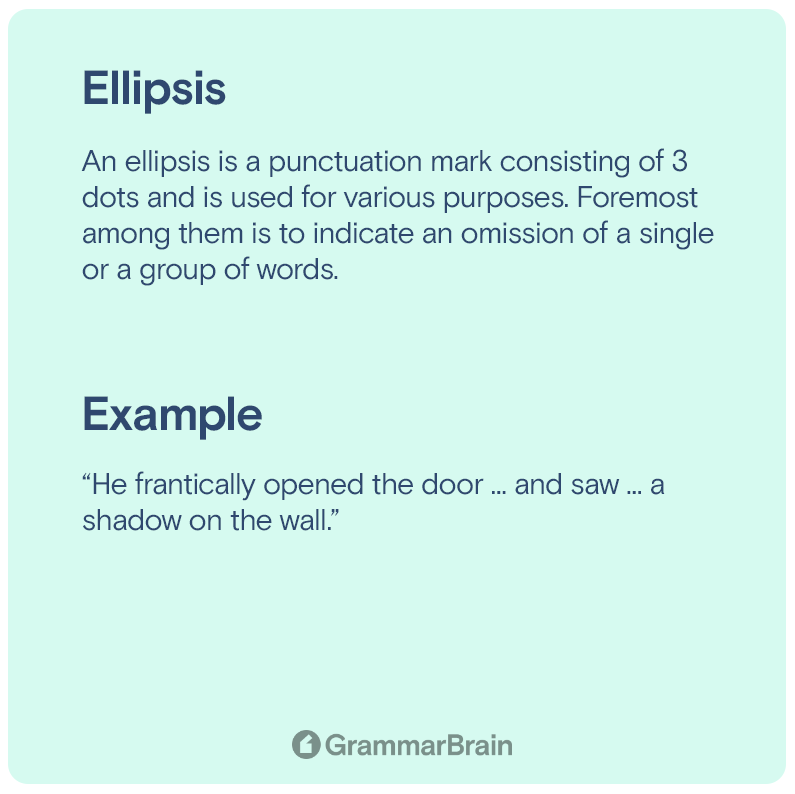
What is an ellipsis?
An ellipsis is a punctuation mark consisting of 3 dots and is used for various purposes. Foremost among them is to indicate an omission of a single or a group of words.
Other purposes include creating a pause for effect, demonstrating an unfinished thought, and trailing off into silence.
The word ellipsis is originally a Latin word, which is derived from the Greek word ‘elleipsis’ which in turn is derived from another Greek word ‘elleipein’. ‘Elleipein’ means to leave out.
Example: “After making a visit to the grocery store, which is two streets away, I returned to my home.”
We can shorten this sentence with an ellipsis: “After making a visit to the grocery store … I returned to my home.”
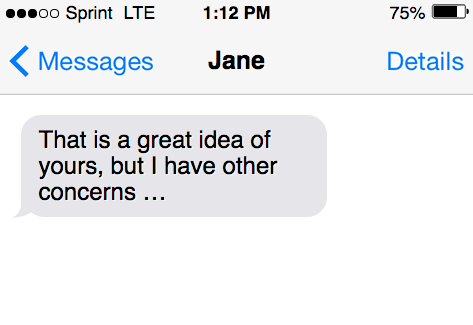
How many periods or dots does an ellipsis have?
An ellipsis is comprised of exactly 3 dots or periods. When a sentence ends with an ellipsis, then it is accompanied by a period which makes it 4 dots in succession.
When to use an ellipsis
As mentioned earlier, an ellipsis is used primarily for 4 reasons.
1) Omission of text:
This is done to remove irrelevant information from a sentence, saving space and time. The replacement of these unwanted or excessive words with an ellipsis will help retain the overall meaning of the sentence.
“Yesterday, after hours of careful deliberation, we passed the amendment.”
“Yesterday … we passed the amendment.”
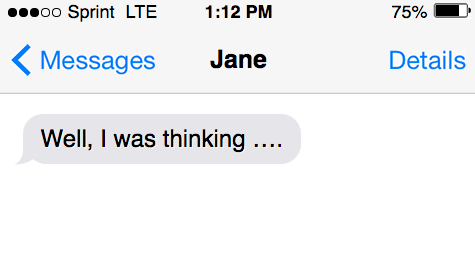
2) Pause for effect:
Here an ellipsis is used as an effective instrument to create a pause or suspenseful effect on the reader.
“He frantically opened the door … and saw … a shadow on the wall.”
This however can only be used in informal and fiction-type writing and should be avoided in formal and academic writing.
3) Unfinished thought:
Here, an ellipsis is used to express a thought that has been left unsaid.
Example: “Well, I was thinking ….”
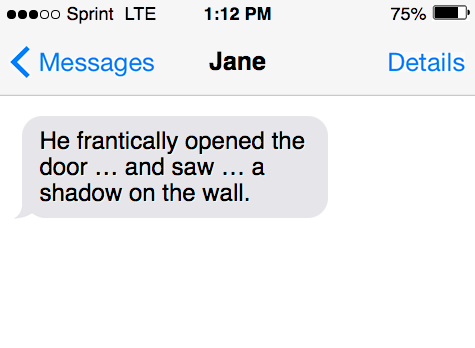
4) Trail off into silence:
Here, the ellipsis is used to denote the progressive softening of the speaker’s voice until it becomes silent.
Example: “But I thought he was …”
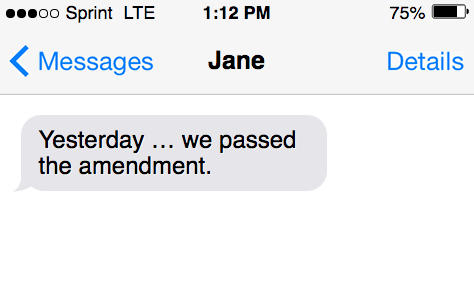
When to avoid using an ellipsis
While the use of ellipsis can come in handy on many occasions, the writer should be careful to avoid using them for the following purposes.
1) Using ellipsis like a written form of ‘erm’ or ‘er’
It is common practice to trail off in the middle of spoken conversations.
One might use ‘er’ or ‘erm’ as a trailing off expression during conversations. But a similar use of ellipsis in written text can be very irritating to the reader.
This is because the reader will be left bewildered. Therefore, its considered a best practice to complete the sentences and not leave any puzzling blanks.
2) Omission of essential parts in a quotation
Often, it’s desirable to condense quoted texts and use an ellipsis to imply that you have shortened the original text.
But this should not get done at the expense of altering the original intent of the source. Thus, omission of critical words that can result in a variation of the original meaning should get avoided.
3) Trail off for no reason
Trailing off with an ellipse at the end of a sentence can often be puzzling to the reader if the intentions of the writer have not been expressed clearly beforehand.
For example, in the sentence “It should be no problem for me to see you tomorrow …” the ellipsis at the end suggests that something might be bothering the writer about seeing the second person.
It can even suggest indecision on the part of the writer. Here, the reader is left confused and wanting clarification. Meaning, it’s best to state the reason for the hesitation (in the writer’s mind to meet the other person).
4) Risk of sounding condescending
Sometimes, trailing off can appear condescending to the readers. In that the writer assumes that the things left unsaid are too obvious.
This might better suit social media status updates that are intended to have a mysterious effect on readers.
But for all other purposes, including academic and business-related ones, it’s best to explain things properly.
Example: “That is a great idea of yours, but I have other concerns …”
A better expression would be: “That is a great idea of yours, but I have important backlogs of previous assignments to complete.”
What is the plural word for ellipsis
The plural word for ellipsis is ellipses.
Difference between ellipsis and ellipses
An ellipse denotes a singular punctuation mark comprising three dots, whereas the plural word ‘ellipses’ refers to the punctuation mark in general.
Examples of the word “ellipsis” in sentences
The word ellipsis as such means omission of superfluous words from speech or writing.
Example 1: An ellipsis cannot occur without a linguistic antecedent.
Example 2: An ellipsis can often be usefully employed to save printing space in books and time for readers.
Examples of an ellipsis used in literature
In literature, an ellipsis can be employed as a stylistic narrative device to condense time. It can also encourage the reader to use his power of imagination to fill in the blanks by himself.
Ernest Hemingway, who postulated the ‘Iceberg theory’, also known as the theory of omission, extensively used ellipses in his works. The famous English writer Virginia Woolf’s ‘To the Lighthouse’ contains numerous popular instances of literary ellipses.
In F. Scott Fitzgerald’s ‘Great Gatsby’, an ellipsis is used to represent a time-lapse in a particular passage. “… I was standing beside his bed, and he was sitting up between the sheets, clad in his underwear, with a great portfolio in his hands.” The readers must use their own imagination to determine how the two characters came into this situation.
In his poem ‘Dream Variations’, Langston Hughes employs ellipses to portray a dreamy trailing off to allow the reader to picture his dream.
Rest at pale evening . . .
A tall, slim tree . . .
Night coming tenderly
Black like me.
Sources:
1) Ellipsis Definition & Meaning – Merriam-Webster
2) Ellipsis: Explanation and Examples – Grammar Monster
3) The five most annoying ways to use an ellipsis
4) Ellipsis (narrative device) – Wikipedia
5) Ellipsis Examples in Literature
Inside this article
Fact checked:
Content is rigorously reviewed by a team of qualified and experienced fact checkers. Fact checkers review articles for factual accuracy, relevance, and timeliness. Learn more.
Core lessons
Glossary
- Abstract Noun
- Accusative Case
- Anecdote
- Antonym
- Active Sentence
- Adverb
- Adjective
- Allegory
- Alliteration
- Adjective Clause
- Adjective Phrase
- Ampersand
- Anastrophe
- Adverbial Clause
- Appositive Phrase
- Clause
- Compound Adjective
- Complex Sentence
- Compound Words
- Compound Predicate
- Common Noun
- Comparative Adjective
- Comparative and Superlative
- Compound Noun
- Compound Subject
- Compound Sentence
- Copular Verb
- Collective Noun
- Colloquialism
- Conciseness
- Consonance
- Conditional
- Concrete Noun
- Conjunction
- Conjugation
- Conditional Sentence
- Comma Splice
- Correlative Conjunction
- Coordinating Conjunction
- Coordinate Adjective
- Cumulative Adjective
- Dative Case
- Determiner
- Declarative Sentence
- Declarative Statement
- Direct Object Pronoun
- Direct Object
- Diction
- Diphthong
- Dangling Modifier
- Demonstrative Pronoun
- Demonstrative Adjective
- Direct Characterization
- Definite Article
- Doublespeak
- False Dilemma Fallacy
- Future Perfect Progressive
- Future Simple
- Future Perfect Continuous
- Future Perfect
- First Conditional
- Irregular Adjective
- Irregular Verb
- Imperative Sentence
- Indefinite Article
- Intransitive Verb
- Introductory Phrase
- Indefinite Pronoun
- Indirect Characterization
- Interrogative Sentence
- Intensive Pronoun
- Inanimate Object
- Indefinite Tense
- Infinitive Phrase
- Interjection
- Intensifier
- Infinitive
- Indicative Mood
- Participle
- Parallelism
- Prepositional Phrase
- Past Simple Tense
- Past Continuous Tense
- Past Perfect Tense
- Past Progressive Tense
- Present Simple Tense
- Present Perfect Tense
- Personal Pronoun
- Personification
- Persuasive Writing
- Parallel Structure
- Phrasal Verb
- Predicate Adjective
- Predicate Nominative
- Phonetic Language
- Plural Noun
- Punctuation
- Punctuation Marks
- Preposition
- Preposition of Place
- Parts of Speech
- Possessive Adjective
- Possessive Determiner
- Possessive Case
- Possessive Noun
- Proper Adjective
- Proper Noun
- Present Participle
- Prefix
- Predicate



